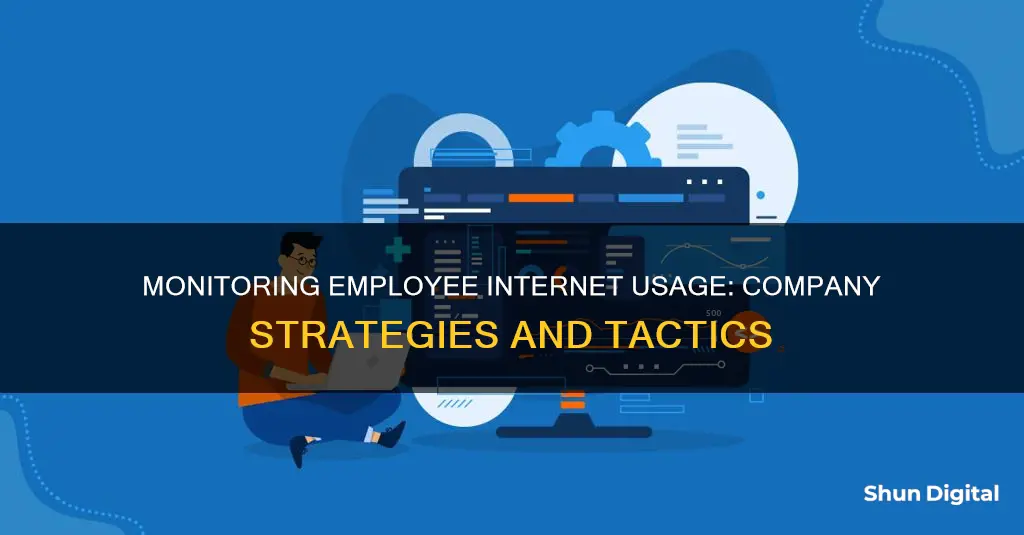
Monitoring employee internet usage is a common practice for many companies, especially with the rise of remote work. There are various methods and tools for tracking internet usage, such as time-tracking software, project management software, communication tools, and web and application monitoring. While monitoring employee internet usage can have benefits such as increased productivity and accountability, it also raises concerns about privacy and ethical boundaries. Companies must balance their business interests with respecting employee privacy rights and obtaining consent for monitoring practices.
| Characteristics | Values |
|---|---|
| Purpose | Protect company assets and ensure smooth functioning of daily operations |
| Productivity | Increased productivity |
| Security | Fewer security risks |
| Accountability | More accountability |
| Compliance | Comply with legal and regulatory requirements |
| Training | Identify training needs |
| Data Security | Protect company data |
| Performance | Track performance |
| Time Theft | Defend against time theft |
What You'll Learn
- Monitoring employee internet usage can increase productivity
- Companies can use software to track employee internet activity
- Monitoring employee internet usage can help protect company information
- Monitoring employee internet usage can help identify training needs
- Monitoring employee internet usage can help ensure compliance with legal and regulatory requirements

Monitoring employee internet usage can increase productivity
Firstly, it's important to note that monitoring employee internet usage can be a delicate matter, as it may raise concerns about privacy and potential misuse. However, when done right, it can bring about several benefits, including increased productivity.
- Use of monitoring software: Specialized employee monitoring software (EMS) can track internet usage patterns, record screens, track websites visited, monitor applications used, log keystrokes, and more. This provides employers with valuable insights into employee activities and can help identify potential distractions or time-wasting activities.
- Restrict internet usage: If your company handles sensitive information, restricting web browsing to specific apps or websites necessary for employees' jobs can help maintain focus and productivity. This can be implemented through software or policies that require the use of company devices for work.
- Implement a BYOD (Bring Your Own Device) policy: Allowing employees to use their personal devices for non-work-related activities during breaks can boost morale and productivity. Emphasize that personal devices are for personal use, and work tasks should be performed on company devices.
- Ban specific websites: Use web filters and geofencing programs to limit access to certain sites deemed inappropriate or non-work-related. This can include pornographic, adult, or social media sites that may distract employees.
- Time tracking software: These tools allow employees to log their work hours and track time spent on specific tasks. Features like screenshots, activity levels, and idle time monitoring can help identify unproductive behaviours.
- Performance analytics: By analyzing employee productivity, efficiency, and output, employers can gain insights into potential productivity issues and address them accordingly.
- Communication and collaboration tools: Instant messaging platforms, video conferencing software, and project collaboration tools can be used to track employee responsiveness and collaboration.
- Establish clear policies: Develop and communicate clear policies and guidelines regarding internet usage, data security, and acceptable computer usage. This promotes transparency and helps employees understand expectations.
- Employee training and awareness: Educate employees on data security best practices, time management, and the importance of appropriate internet usage. This can help prevent time theft and improve overall productivity.
By implementing these strategies, companies can monitor employee internet usage while also fostering a culture of accountability and integrity, leading to increased productivity.
BlueCross CPAP Usage: Monitored for Better Sleep and Health
You may want to see also

Companies can use software to track employee internet activity
- Time-tracking software: This allows employees to log their work hours and the time spent on specific tasks or projects. It may also include features like screenshots, activity levels, and idle time monitoring.
- Project management software: These platforms help track the progress and status of tasks and projects, and often include features that allow managers to monitor employee workloads, task completion rates, and project timelines.
- Communication and collaboration tools: Instant messaging platforms, video conferencing software, and project collaboration platforms can be used to track employee communication, collaboration, and responsiveness.
- Web and application monitoring: This type of software allows employers to monitor employees’ internet usage, track the websites and applications accessed during work hours, and ensure compliance with company policies.
- Performance analytics: These tools analyze employee productivity, efficiency, and output based on data collected from various tracking sources, and can generate reports and insights to evaluate individual and team performance.
In addition to these methods, companies can also use employee monitoring software (EMS) to track internet activity. EMS enables employers to:
- Record screens and capture video recordings of employee device screens in real time.
- Track websites and log all websites and web pages visited by employees, providing visibility into how much time is spent on non-work-related sites.
- Monitor applications and track the use of applications, including time spent on each app.
- Log keystrokes and record keys typed on keyboards, including chat messages, emails, documents, and search terms.
- Monitor network traffic and analyze overall bandwidth usage and internet activity, with sudden spikes indicating potential unauthorized content streaming.
- Track time and provide insights into time spent on websites and applications, allowing for an assessment of productivity.
- Measure productivity and generate scores based on websites visited and applications used, with alerts sent to employees if their internet use productivity score falls below expectations.
- Set alerts for attempts to access prohibited sites or content, allowing security staff to take immediate action.
Overall, the use of software to track employee internet activity can provide companies with valuable insights to improve productivity, enhance security, and ensure compliance with policies and regulations. However, it is important to note that employee privacy concerns must be addressed through transparent policies and informed consent.
Electricity Usage Monitoring: What UK Energy Companies Can See
You may want to see also

Monitoring employee internet usage can help protect company information
Monitoring employee internet usage is an important way for companies to protect their information and assets. With employees using company devices and networks, unmonitored internet use can increase security risks, impact productivity, and compromise company resources and data.
Employee monitoring software can help prevent the unauthorized sharing or leakage of corporate data. For example, managers can use the software to identify employees who are spending excessive time on non-work-related websites or social media during work hours. This information can then be used to implement targeted training programs or policies to address these concerns and improve efficiency.
Additionally, monitoring employee internet usage can help companies comply with legal and regulatory requirements, especially in highly regulated industries such as finance and healthcare. If employees are aware that their internet use is being monitored, they may be more likely to stick to company guidelines and less likely to engage in unethical behavior.
It's important to note that employers must balance protecting their interests with respecting employees' privacy rights. This means being transparent about monitoring policies, obtaining consent, and only collecting and storing data necessary for the intended purpose of improving productivity and safeguarding company assets.
By taking a measured approach, companies can strike an effective balance between monitoring employee internet usage to protect company information and respecting employee privacy.
Battery-Sapping Security Apps: Monitor Your Usage
You may want to see also

Monitoring employee internet usage can help identify training needs
For example, monitoring tools can highlight excessive time spent on non-work-related websites or social media platforms during work hours, indicating that employees may benefit from training on time management and maintaining focus. This data can be used to implement targeted training programs to address these issues and improve overall efficiency.
Additionally, monitoring employee internet usage can identify skills gaps and knowledge deficiencies. By tracking the websites visited and applications used, organizations can determine areas where employees spend excessive time or lack proficiency. This information can be used to develop tailored training programs to bridge these gaps and enhance employee competence.
Furthermore, monitoring can also help enforce compliance with company policies and regulations, especially in industries like finance or healthcare. By tracking internet activity, organizations can ensure employees adhere to guidelines and reduce the likelihood of unethical behavior or misconduct. This fosters a culture of accountability and integrity within the organization.
It is important to note that while monitoring employee internet usage can provide valuable insights, organizations must also respect employee privacy and adhere to legal regulations. Clear policies and informed consent are crucial to maintaining a balance between monitoring and employee trust.
Monitoring Employee Internet Usage: What Employers Can and Can't Do
You may want to see also

Monitoring employee internet usage can help ensure compliance with legal and regulatory requirements
Monitoring employee internet usage is essential for companies to ensure compliance with legal and regulatory requirements, especially in highly regulated industries like finance and healthcare. By tracking internet activity, companies can gain insights into potential misconduct or unethical behaviour by employees, helping them adhere to legal and regulatory standards.
For instance, monitoring can prevent employees from engaging in unauthorized sharing or leakage of corporate data, reducing the risk of insider threats. This is crucial as 60% of cyber-attacks originate from within organizations. Additionally, monitoring can help identify employees who access explicit or gambling websites, which could violate acceptable use policies. Furthermore, tracking can ensure employees are not spending excessive time on non-work-related websites during work hours, improving productivity and efficiency.
Another benefit of monitoring employee internet usage is the ability to comply with data security regulations such as Sarbanes-Oxley, HIPAA, or the EU's GDPR. Monitoring systems can scan outgoing files, emails, and chats, flagging or blocking messages that seem to violate these policies. This helps prevent data breaches and ensures compliance with legal and regulatory requirements.
To ensure effective monitoring, companies should establish clear policies, obtain employee consent, and respect privacy rights and legal regulations. Transparent communication with employees about monitoring practices is essential to maintaining trust and addressing privacy concerns.
Electricity Usage: Are Police Monitoring Your Power Consumption?
You may want to see also
Frequently asked questions
Companies monitor employee internet usage to increase productivity, ensure security, and improve accountability. Monitoring can also help companies comply with legal and regulatory requirements.
Common methods include using time-tracking software, project management software, communication and collaboration tools, and web and application monitoring software.
Monitoring employee internet usage can help identify potential blockers to productivity, such as excessive time spent on non-work-related websites. It can also help protect company information and intellectual property, and identify training needs.
Privacy concerns are a significant challenge. Monitoring employee internet usage can also be technically complex and costly to implement and maintain. There is also a potential for misuse, which can lead to legal ramifications.







